ISSN ONLINE(2320-9801) PRINT (2320-9798)
ISSN ONLINE(2320-9801) PRINT (2320-9798)
JatinGupta1, Nivit Gill2
|
| Related article at Pubmed, Scholar Google |
Visit for more related articles at International Journal of Innovative Research in Computer and Communication Engineering
MANET (Mobile Ad Hoc Network) is a network of mobile devices that communicates through wireless links without the use of any existing network infrastructure or centralized administration [1]. There is no fixed topology of the nodes because of the high mobility of the nodes within network. Many routing protocols for mobile ad hoc networks (MANETs) rely on additional information such as geographical locations obtained via GPS to improve the overall performance of the route discovery process. The GRP is one of such routing protocol which is proactive, distance-based, greedy algorithm which assumes that each node in the network knows its own GPS location. In this paper the major goal is to tune the performance of Geographical routing protocol (GRP) with controlled initial flooding
Keywords |
| GRP, ROUTING, FLOODING, IFGRP, OPNET |
INTRODUCTION |
| Ad-Hoc Networks (MANETs) are mobile networks that communicate with each other without the need to a central structure also; the MANET networks are specific type of networks without infrastructure. Ad hoc network is a collection of mobile nodes that communicate with each other without any centralized control and infrastructure. In this paper the study focuses is on the issue of using geographical location information to enhance performance parameters which are associated with the route discovery process. MANET routing protocols often rely on flooding to find a route to destination. Flooding is a simple and effective technique for route discovery where each node broadcasts route request message to all of its neighbours. The neighbouring nodes repeat the process until a route to destination is found. The message broadcasts are usually “heard” by all the neighbouring nodes, including those that have already “seen” (i.e., forwarded) that message. To deal with such situations, MANET routing protocols typically include a mechanism that allows the nodes to identify and discard message duplicates. However, flooding often leads to unnecessary large control message overhead since the whole network is being searched, including the parts of the network that do not contain a route to destination [1]. |
| Geographic Routing Protocol (GRP) – GRP is an OPNET’s custom MANET routing protocol who’s routing is based on shortest geographical distance between source and destination. Each node uses the GPS to identify its own position. It is proactive routing protocol where routes are availableonly whenroutes are needed. The GRP uses the quadrants scheme to optimize the flooding. Initially the network wide is flood to identify all nodes in the network the flooding position updates on distance moved and neighbourhood crossings. The Quadrant size is user controlled and hello protocol here is used to identify neighbours and their positions. Backtracking is used on blocked routes in GRP. Nodes that receive the backtrack packet calculate the next closest neighbour node to the destination and sends it along the new path. If a node that receives a backtrack packet has no alternate route, it in turn backtracks to its previous node to find an alternate route at the end if no alternate route is available after all the recursive backtracks (till source is reached), the packet is dropped and discarded. |
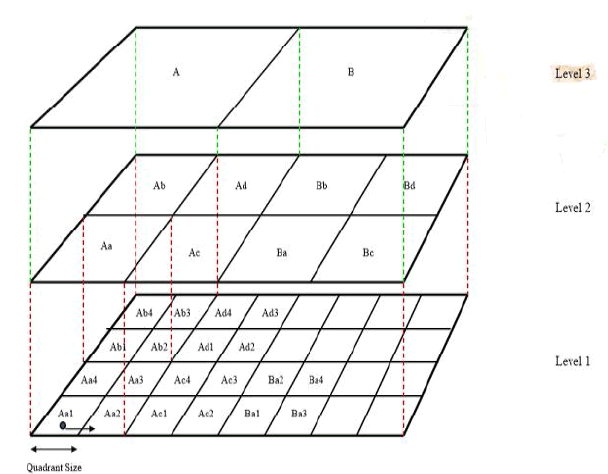 |
| All quadrants are squares. The size of the quadrant is specified by the user in metres.The entire world is divided into quadrants. Latitude, Longitude (-90, -180) to Lat, Long (+90, +180).Given the position of a node, it is easy to determine which quadrant it lies in. Every 4 quadrants (in the form of a square) make up a higher level quadrant. Aa1, Aa2, Aa3 and Aa4 are individual quadrants at Level 1. They form quadrant Aa at Level 2 and Aa, Ab, Ac, Ad are individual quadrants at Level 2. They form quadrant A at level 1. |
| GRP Flooding Concepts involves, initially the network flooding is done to know the initial position of every node and the other reachable node in the network. When a node crosses the quadrant boundary the flooding is done again but the extent of flooding is dependent of the distance moved by the node with respect to the quadrant boundary. If a node only moves within its quadrant, flooding packets are sent out to nodes only within the quadrant. If a node moves from quadrant Aa1 to Aa2 (within the level 2 quadrant boundary), then all nodes within quadrant Aa are sent out the flooding message. If a node moves from quadrant Aa2 to Ac1 (within the level 3 quadrant boundary), then all nodes within quadrant A are sent out the flooding message. When the flooding packets are received outside the boundary for which it is intended, the packet is discarded. |
II. RELATED WORK |
| Simulation and Performance Analysis of OLSR Routing Protocol Using OPNET is done Kuldeep Vats, Monika Sachdeva and Dr. Krishan Saluja [1]. The paper conclude the performance of OLSR protocol with network different size is better in all aspects in a network. The performance of OLSR which can be achieved by Hello Traffic Sent (bit/sec), Total TC message sent (TTMS) and Total TC message forward (TTMF), Total hello message and TC traffic sent (bit/sec), Routing traffic received (pkt/s), Routing traffic sent (pkt/s), MPR Count. Improvement in MANETs routing protocols using geographical information done by Vasil Hnatyshin [2].Author conclude that thepossible improvements in GPS protocol including selection of initial value for the flooding angle, dynamically adjusting the flooding angle at intermediate nodes (i.e., increasing the flooding angle value when an intermediate node knows that there are no neighbouring nodes within the request zone defined by the flooding angle carried in arriving RREQ), and few others. |
| Performance Analysis of Routing Protocols for Ad hoc Networks done by Amandeep Verma and Dr. Manpreet Singh Gujral [6]. The author conclude that the performance of GRP is also very close to OLSR but not better than it. As far as the present results are concerned in the given scenario the protocols are ordered in the increasing order of their performance as DSR, AODV, GRP and OLSR. Performance Comparision of IFGRP and Tuned OLSR Routing Protocols in MANETS done by Jatin Gupta, Ishu Gupta and Ritika Gupta [7]. The paper conclude IFGRP perform better than OLSR which is modified or Tuned GRP. The backtracking and the flooding plays big role in improving overall performance of GRP. Design and Implementation of an OPNET model for simulating Geo MANET routing protocol [8]. This paper presents the design and implementation of GeoAODV, a new protocol for improving the performance of AODV route discovery process. GeoAODV takes advantage of the GPS system and uses node coordinates to reduce the search area during the route discovery process. Specifically, this paper describes OPNET architecture for modelling MANET routing protocols and AODV protocol in particular as well as provides a detailed account of the authors’ endeavours to implement GeoAODV routing protocol by extending AODV process model using OPNET Modeler version 14.5. Paper also provides a summary of simulation results which show that with the help of GPS coordinates, Geo routing protocol reduces the control packet overhead during the route discovery process. |
III. SIMULATION STUDY AND PARAMETERS |
| The Simulation study and scenario design for Tuned GRP is carried out with the help of OPNET-14.5. The GRP routing protocol is tuned in study and the study performed on 50 and 75 nodes. The flooding attempt in GRP is set to 1 default where as in tuned it is set to 3. The flooding and the angle to flood plays very important role in tuning the GRP.Flooding value and interval depends on the nodes movement, nodes are allowed to move only 5 meters. Therefore, it is easy to find the node when its last GPS location is known, the search area for node get limited. Then less flooding required discovering reachable nodes. The flooding angle is represented as an integer number, called request level that has the following meaning: |
| Request_level = 1, flooding angle 90Ãâ¹ÃÅ¡ 2, flooding angle 180Ãâ¹ÃÅ¡ |
| 3, flooding angle 360Ãâ¹ÃÅ¡ |
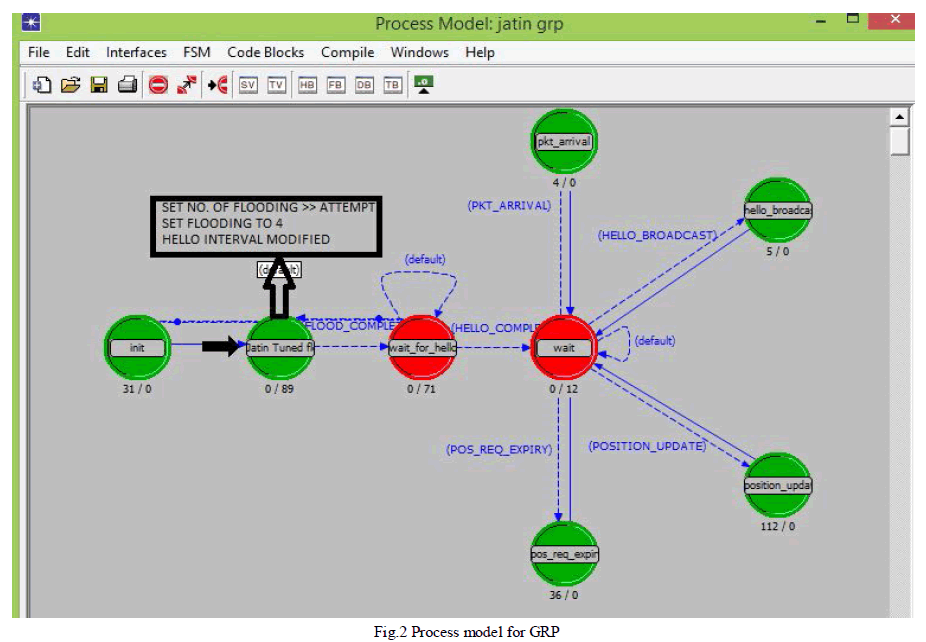 |
| The various simulation parameters are studied, these are as follow: |
| a) Delay (sec)- Represents the end to end delay of all the packets received by the wireless LAN MACs of all WLAN nodes in the network and forwarded to the higher layer. |
| b) Throughput (Bits/Sec)- Represents the total number of bits (in bit/sec) forwarded from wireless LAN layers to higher layers in all WLAN nodes of the network. |
| c) Network load (Bits/sec)- Network load represents the total load in bit/sec submitted to wireless LAN layers by all higher layers in all WLAN nodes of the network. When there is more traffic coming on the network, and it is difficult for the network to handle all this traffic so it is called the network load. The efficient network can easily cope with large traffic coming in, and to make a best network, many techniques have been introduced.(node network) |
RESULTS |
| a) Delay: Fig. 3 representing the delay for tuned and default GRP for different network size. The green and blue color representing delay for 75 nodes which showing the downward trend as the time progress. Therefore, the GRP perform well for large dense networks. |
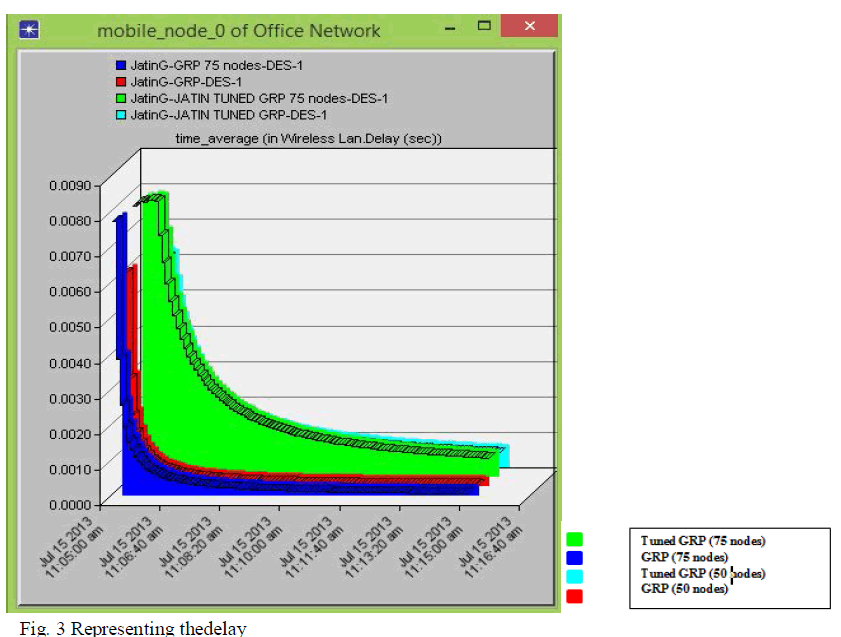 |
| b) Load: Fig.4 is representing the load for tuned and default GRP. The load is also favouring GRP for large dense networks. The load following the same trend as followed by delay above in Fig.3. As the time progress the large networks perform better. The significant increase in load shown by green line giving the idea that the throughput is large as load and throughput follow same pattern [7]. |
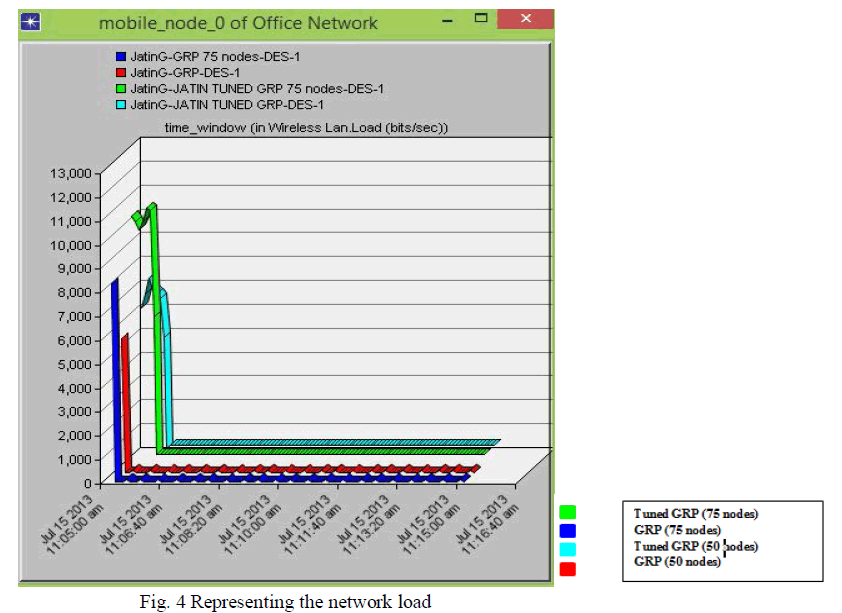 |
| c) Throughput: Fig. 5 is representing the throughput for the tuned and the default GRP. The throughput is most important factor while computing the performance of a routing protocol. The high throughput is desirable always for network. The Green and aqua area are showing the throughput for tuned GRP with 50 and 75 nodes, the simulation showing quite more throughput than shown by the default GRP. The results shown by the tuned GRP are much better. |
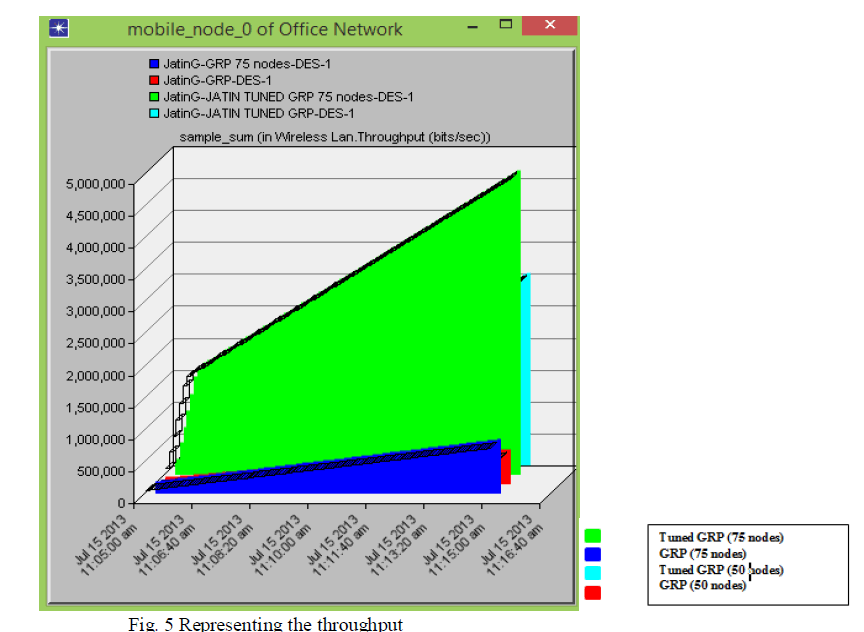 |
V. CONCLUSION |
| The simulation study has shown firstly , that the GRP network suits for large networks, as with the progress of time the load and delay starts to decline. The throughput shown by tuned GRP in both network sizes are showing the outstanding results for throughput, therefore the flooding angle shows the great impact on the overall performance of GRP routing protocol. The mobility range is restricted to limited range which helps in control flooding. The overall conclusion is large network with controlled flooding and movement better the GRP overall performance. |
References |
|